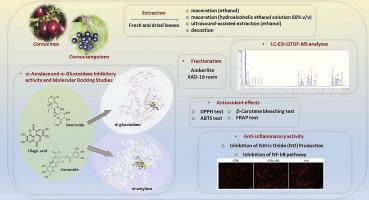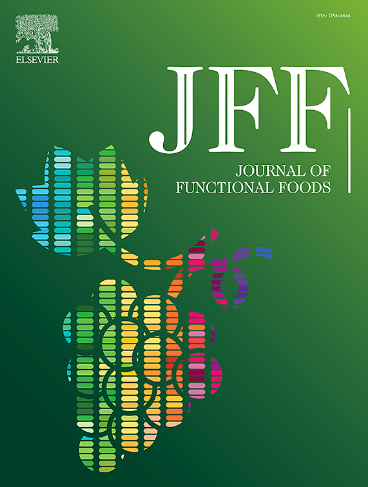探索作为生物活性化合物来源的副产物:血枝茱萸和山茱萸叶提取物和组分的LC-ESI-QTOF-MS分析和生物活性评估
IF 4
2区 农林科学
Q2 FOOD SCIENCE & TECHNOLOGY
引用次数: 0
摘要
随着慢性病发病率的增加,人们对农工副产品中生物活性化合物的兴趣也在增加。本研究通过不同的提取方法对山茱萸和血山茱萸叶提取物的化学成分和生物活性进行了研究,重点研究了鲜为人知的血山茱萸。研究评估了它们的抗炎特性(抑制NF-κB、一氧化氮还原)、抗氧化活性和降糖作用(抑制α-淀粉酶和α-葡萄糖苷酶)。LC-ESI-QTOF-MS分析鉴定出主要成分为酚酸、环烯醚萜和类黄酮。用XAD-16树脂对干燥的血血藤和新鲜血血藤进行醇浸和乙醇浸。生物活性测试的部分和三个关键化合物:草苷,角草苷,鞣花酸。草苷和角苷对NO的产生有较强的抑制作用。此外,苦参苷具有明显的α-葡萄糖苷酶抑制作用。这些发现强调了山茱萸叶的潜在益处,为开发以山茱萸为基础的产品来预防或治疗2型糖尿病和炎症提供了基础。本文章由计算机程序翻译,如有差异,请以英文原文为准。

Exploring by-products as sources of bioactive compounds: LC-ESI-QTOF-MS profiling and bioactivity assessment of blood twig dogwood and cornelian cherry leaf extracts and fractions
The increasing incidence of chronic diseases, interest in bioactive compounds from agro-industrial by-products is increasing. This study explored the chemical profile and bioactivities of Cornus mas and Cornus sanguinea leaf extracts obtained through various extraction methods, especially focusing on the lesser-known C. sanguinea. The study assessed their anti-inflammatory properties (inhibition of NF-κB, nitric oxide reduction), antioxidant activity, and hypoglycaemic effects (inhibition of α-amylase and α-glucosidase). LC-ESI-QTOF-MS analysis identified phenolic acids, iridoids, and flavonoids as key constituents. Hydroalcoholic maceration of dried C. mas and ethanol maceration of fresh C. sanguinea were fractionated using XAD-16 resin. Bioactivity was tested on fractions and on three key compounds: sweroside, cornuside, and ellagic acid. Sweroside and cornuside inhibited highly NO production. Moreover, sweroside exhibited a notable α-glucosidase inhibition. These findings highlight the potential benefits of Cornus leaves, providing a basis to develop Cornus-based products for the prevention or treatments for type 2 diabetes and inflammation.
求助全文
通过发布文献求助,成功后即可免费获取论文全文。
去求助
来源期刊

Journal of Functional Foods
FOOD SCIENCE & TECHNOLOGY-
CiteScore
9.60
自引率
1.80%
发文量
428
审稿时长
76 days
期刊介绍:
Journal of Functional Foods continues with the same aims and scope, editorial team, submission system and rigorous peer review. We give authors the possibility to publish their top-quality papers in a well-established leading journal in the food and nutrition fields. The Journal will keep its rigorous criteria to screen high impact research addressing relevant scientific topics and performed by sound methodologies.
The Journal of Functional Foods aims to bring together the results of fundamental and applied research into healthy foods and biologically active food ingredients.
The Journal is centered in the specific area at the boundaries among food technology, nutrition and health welcoming papers having a good interdisciplinary approach. The Journal will cover the fields of plant bioactives; dietary fibre, probiotics; functional lipids; bioactive peptides; vitamins, minerals and botanicals and other dietary supplements. Nutritional and technological aspects related to the development of functional foods and beverages are of core interest to the journal. Experimental works dealing with food digestion, bioavailability of food bioactives and on the mechanisms by which foods and their components are able to modulate physiological parameters connected with disease prevention are of particular interest as well as those dealing with personalized nutrition and nutritional needs in pathological subjects.
 求助内容:
求助内容: 应助结果提醒方式:
应助结果提醒方式:


